By Jeffrey A. Rendall, Photos By Jeff Janas
|
|
HAYMARKET, VA -- The double take -- Webster's Dictionary defines it: a delayed reaction to some remark, situation, etc., in which there is at first unthinking acceptance, then startled surprise or a second glance as the real meaning or actual situation becomes clear.
It's certainly a rare occasion when something like a golf course causes a double take, but that's possibly what you'll do when checking out Piedmont Club, located just north of I-66 in the growing hamlet of Haymarket, Virginia.
The double take involved there has all positive connotations, I'm happy to report, for what at first might appear to be just another golf course located in a burgeoning new residential development, turns out to be much more. Piedmont's course designer, Tom Fazio, took a chunk of what he describes as some of the prettiest land in the state and molded it into a playable, fun golf course.
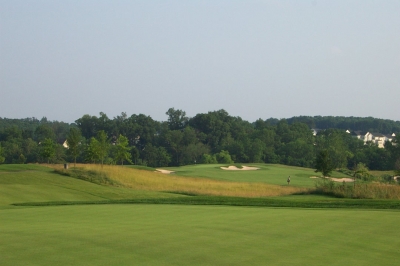 |
| Everything just seems to fit in place at Piedmont Club -- it's a very natural environment for golf. |
It's got a few surprises, too (hence the double takes). Fazio explains: "We always take the best attributes of every site, and do our best to provide an enjoyable golf course for the people who play there. Every site is different, and there's really no blueprint involved when laying out golf holes."
He continues, "Piedmont has a wonderful setting. The golf course runs through very historic ground (it's a few miles west of Manassas National Battlefield Park), and you just get the overall feeling -- the ambiance of the environment and open space and rolling terrain and vegetation. Put that together with the long range views of the mountains, and that really gave us the setting, the set-up for the golf experience."
"Then we worked on building a distinctive golf course, to include the different perspectives of players who'll be seeing it. Obviously, with Piedmont being a private club, you want a course that members will enjoy on a regular basis, but you also want to create something guests or visitors will like when playing it for the first time. People of all levels like to see variety in the design, and that's why we built in some different looks on the course," Fazio added.
One particular double take you're certain to make is when reaching the seventh green, which is very much in the 'Pinehurst' style, with a raised, undulating putting surface, roll-offs to the sides, and shaved chipping areas. It hardly looks out of character on the course, though you'll certainly notice it when you see it.
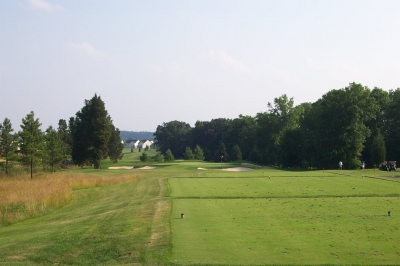 |
| The scorecard says the 175 yard, par three 16th hole is the easiest on the course. If the pin's tucked in behind one of those bunkers, it's still a challenge to make par. |
Fazio says it was something different, to add an additional, memorable element: "We weren't trying to create a 'Pinehurst look' with the seventh green, as much as we were trying to mix in some different styles of golf holes. If you're in Pinehurst, you might design the greens in that type of style, because when people come there, they'll be disappointed if they don't get that."
"In other places, you can give them a little bit of a taste of something like that crowned type green, or little pieces of all the different kinds of shots. And that's what we did at Piedmont," Fazio added.
Again, looking at the course, you'll see an attractively maintained set of links conforming nicely to the land, with environmental areas sprinkled here and there, tall fescue bordering many of the rough areas, and several ponds and streams. You're also probably thinking Piedmont's wide landing areas and tepid yardage figures will lend themselves to a less than taxing round of golf.
Better get ready for another double take. Piedmont's back tees measure 7001 yards, but carry a slope rating of 144. That high number even surprises the professional staff.
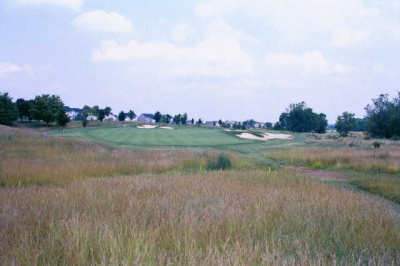 |
| Piedmont views -- pristine playing surfaces, deep fairway bunkers and tall fescue. Here, the 2nd hole. |
John 'Monty' Montgomery, Piedmont's Head Golf Professional, explains: "I'd say we have very generous fairways, yet our slope rating is amongst the highest in Virginia. Does that mean we're one of the toughest courses in the state? I question that, because there's more than enough room to land the ball here."
"The answer we received from the VSGA (Virginia State Golf Association, which rated the course) was, when they were calculating the various elements, that the depth of our fairway bunkers is equivalent to the average depth of a greenside bunker. That makes them pretty deep, though the course certainly isn't tricked up or anything. So you've got a lot of room off the tee, but if you hit a bad drive and end up in a fairway bunker, you'll have a tough time getting to the green on your second shot," Monty said.
Remembering back, there were some pretty steep bunkers lining the fairways -- but whatever you do, don't call them 'severe.' That's all a matter of perception, according to the course's designer.
"Even though Piedmont provided a wonderful environment for golf... we felt that building some strength into the fairway bunkers would add a degree of challenge, versus very flat, kind of 'easy' bunkers," Fazio said. "I was concerned that maybe, the perception of it, the feeling would be that the golf course has less challenge to it otherwise. It puts a player on notice, off the tee, that the strength of the course is in the fairway bunkering."
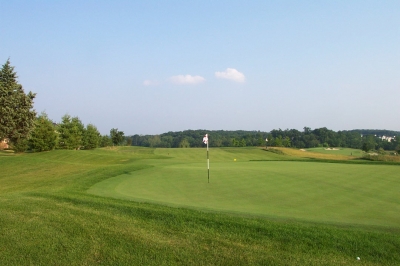 |
| From the back of the 9th green, you'll see why Tom Fazio said this is a beautiful part of Virginia. |
"Think of it this way -- golf courses in the British Isles -- everyone knows, the toughest part of those courses is in the bunkering. To score well, you certainly must stay out of them, like Tiger Woods did when he won at St. Andrews (in 2000), where he didn't hit into a single bunker in four rounds," Fazio continued.
"The bunkers over there are extremely deep, almost not playable, especially those in the fairway. Well, it's not quite that way in American golf, where you get a little spoiled and say 'they're severe' when you can't reach a green from the fairway sand. But who said you're supposed to be able to reach the green from a fairway bunker in the first place? Just because you're used to it in some places doesn't mean it's always destined to be that way," Fazio said.
In other words, at Piedmont, hitting into the fairway traps is the proverbial half-to-one-shot penalty, thanks to Fazio's allusions to golf across the pond.
Monty says it's more than just the bunkering that adds variety and challenge to Piedmont's golf course. "This is definitely a second shot golf course. It's fairly easy to keep the ball in play, but then you've got some work to do when approaching the greens."
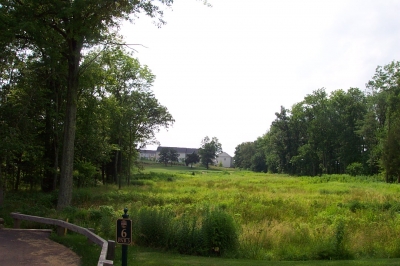 |
| Yes, there is a green in the distance at the par three 6th hole -- you'll just have to fly your ball there to find it. |
And should you misfire on those approach shots, expect to use some imagination to try and save par. "One of the things I like most about Fazio's design is the variety around the greens," Monty said. "It's nice to see a designer putting in some chipping areas instead of just greenside bunkers. Fazio did an excellent job, particularly on our par threes, of designing some very creative short shots. I think he's brought a little bit of the old-style back, in that respect."
Monty also says the greens will put up a defense, when they're cut short: "The greens can get pretty quick and a bit treacherous, because they don't really have obvious breaks. They're very subtle, and when they're running quick, they'll play tricks on you."
Both Fazio and Monty agree that the layout's high slope rating will come down, once the course fully grows in (which it looks like it has), and some of the taller fescue areas will be trimmed. As has been the case throughout the season (2003), the fescue's going crazy with the amount of rain we're experiencing.
Tall fescue or not, another attractive aspect at Piedmont is its walk-ability. Monty says in this day and age, that's a big plus: "I think another thing that's unique about our course is how enjoyable it is to walk it. The greens and tees are very close, so the way the holes are set up, they're very convenient. And really the only 'severe' elevation change is walking up eighteen (512 yard par five). I think that's been a major factor in attracting members."
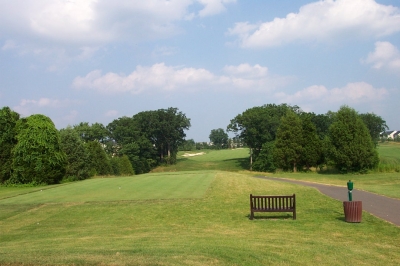 |
| It's an intimidating sight from the tee box of the par four 10th hole, but it shouldn't be too much trouble to reach the fairway safely. |
Other major factors include the highlight holes, starting with the fifth hole (369 yard par four). Piedmont's first four holes are largely open, with few trees defining the corridors. That changes once you reach hole five, a shortish par four with trees on both sides. It's a slight dogleg left, and the key is aligning your feet properly off the tee to reach the right spot on the fairway -- since a hazard runs the entire length of the hole on the left side.
The aforementioned seventh hole is a highlight because of the Pinehurst style green. Since a less than precise second shot will likely roll off the green, club selection and placement is paramount on this 420 yard hole. A large bunker protects front and right of the green as well. A well conceived, thoughtful hole.
On the inward nine, the thirteenth hole probably rates highly on most everyone's list of favorites (including with our member playing partners, Dr. Howard and John Topper). Monty does the description honors: "Thirteen's one of the best par threes I've ever played. The way the green's cut at an angle along the water hazard -- that's extremely well done. From the back tees, it's a bear of a hole, with really only a little room on the right to potentially miss."
The closing hole also leaves impressions. At 512 yards, it's the ideal risk-reward length. After a solid tee shot, you'll have the option to go for the elevated green in two, but you're firing over a mowed ravine to an elevated putting surface. A set of bunkers protects short-left, and trees might catch a shot from the right with too much draw. The clubhouse makes for a dramatic backdrop to the concluding hole.
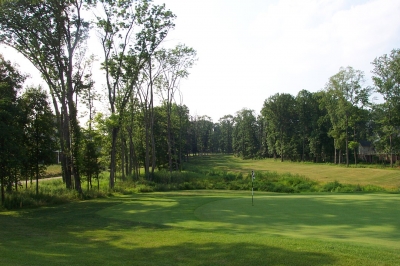 |
| The par three 13th hole is one of those where you can't afford to let its beauty distract you -- or possible penalties await. |
The Piedmont experience need not end there. The large clubhouse includes a full service restaurant, a banquet room, and a private library for members, just right for private business functions, meetings or conferences. There're also full service men's and ladies locker rooms, bag storage and a steam room.
In other words, you might just change your first set of impressions when visiting Piedmont Club -- it's much more than just a residential community country club. All in all, the perfect opportunity to test your double take reflex.
Note: Membership can also include a workout room and outdoor/indoor swimming pools in the Piedmont community, for a small additional monthly fee.
Details:
Piedmont Club
14675 Piedmont Vista Dr.
Haymarket, VA 20169
Phone: (703) 753-9240
Website: www.piedmontclub.com
Course Designer: Tom Fazio
General Manager: Karl Swink
Head Golf Professional: John 'Monty' Montgomery
Superintendent: Mike King
| Tees | Yardage/Slope | Rating |
| Gold | 7001/144 | 74.4 |
| Blue | 6484/138 | 71.9 |
| White | 5949/130, 132 (L) | 69.4, 74.3 (L) |
| Red | 5273/124 | 70.1 |
Membership:
At press time, a limited number of memberships were still available. Contact Patti Hulsebus at (703) 753-5922 extension 222 for inquiries.
Piedmont Club is owned and operated by ClubCorp, which adds an extra touch of class and service sophistication.
| Related Links | Comments on this article? | |
|
Maryland National Golf Club Hollow Creek Golf Club Rocky Gap Resort PB Dye Golf Club in Ijamsville Whiskey Creek Golf Club |
E-mail Jeff Rendall, Editor: jrendall@golftheunitedstates.com |












